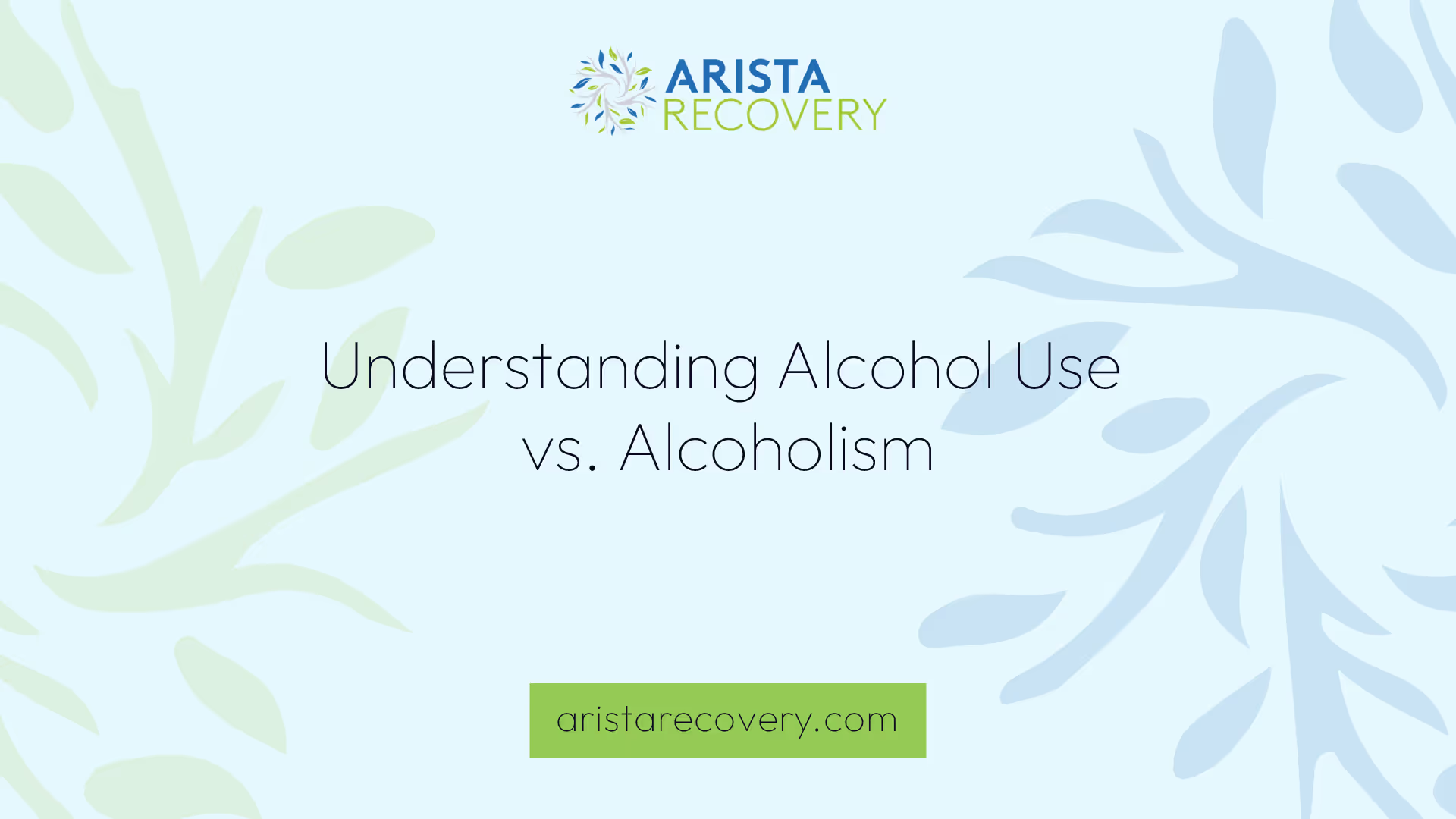Understanding Alcohol Use vs. Alcoholism

Understanding Alcohol Use
Understanding the distinction between casual alcohol use and heavy drinking is crucial in recognizing the thin line between alcohol use and alcoholism. It's also important to consider the demographics of alcohol use to get a clearer picture of the reach and impact of this issue.

Casual Drinking vs. Heavy Drinking
Alcohol use can range from casual drinking to alcoholism, a chronic and relapsing disorder characterized by a strong craving for alcohol and the inability to stop drinking despite harmful consequences.
Casual drinking typically refers to moderate consumption, which for men is up to two drinks per day, and for women, up to one drink per day. Heavy drinking, on the other hand, involves consuming large amounts of alcohol on a regular basis, often leading to physical and psychological dependence.
Alcohol Use Disorder (AUD) includes both alcohol abuse and alcohol dependence. Alcohol abuse refers to a pattern of drinking that results in failure to fulfill major responsibilities at work, school, or home, as well as recurrent use of alcohol in situations where it is physically dangerous. Alcohol dependence means the inability to stop drinking despite wanting to quit, increased tolerance to alcohol, and withdrawal symptoms like nausea, sweating, shakiness, or anxiety when reducing or stopping alcohol use [2].
Alcohol Use Demographics
Alcohol use is common in the United States, with around 86% of people aged 18 or older reporting that they have consumed alcohol at some point in their lives. In addition, around 70% of adults reported drinking in the past year, and approximately 55% reported drinking in the past month.
AUD affects people of all ages, races, and social classes [4]. Recognizing the wide reach of this issue is a crucial step in raising awareness and promoting responsible drinking behaviors.
From Alcohol Use to Alcoholism
Understanding the progression from alcohol use to alcoholism is crucial in recognizing the signs and intervening early. This journey can be divided into two key stages: alcohol abuse and the transition to alcohol dependence.
Recognizing Alcohol Abuse
Alcohol use can range from casual drinking to alcoholism. Alcohol abuse sits somewhere in this spectrum, defined as a pattern of drinking that results in harm to one's health, interpersonal relationships, or ability to work.
It's essential to note that alcohol abuse is not the same as alcoholism, although they are related. Alcohol abuse can lead to alcohol dependence over time, but not all individuals who abuse alcohol will become dependent on it. Recognizing the signs of alcohol abuse can help individuals seek help early and potentially prevent the progression to alcohol dependence.
Transition to Alcohol Dependence
Alcohol dependence, also known as alcoholism, is a chronic disease characterized by uncontrolled drinking and preoccupation with alcohol [5]. A key difference between alcohol abuse and alcohol dependence is the physical dependence and tolerance that develops with alcoholism.
In this stage, the individual often experiences physical withdrawal symptoms when they stop drinking, such as shaking, nausea, and anxiety. They may also need to consume larger amounts of alcohol to achieve the same effect, indicating a developed tolerance.
Alcohol use disorder is a treatable disease that responds well to professional care. Treatment for alcoholism often requires more intensive treatment due to the physical changes in the brain and body compared to alcohol abuse. This may include counseling, medication, self-help groups, and other support services.
Understanding the progression from alcohol use to alcoholism is key to early intervention and successful treatment. If you or someone you know is struggling with alcohol use, seek professional help early. Remember, alcohol use disorder affects people of all ages, races, and social classes, and it's never too late to seek help.
Impacts of Alcoholism
The long-term impacts of alcoholism, a chronic and often relapsing disorder, are far-reaching, affecting both physical health and social or mental well-being. The consequences can be severe, resulting in significant health, social, and economic burdens.
Physical Consequences of Alcoholism
Alcohol use disorder can lead to a range of physical health problems. These include, but are not limited to, liver disease, heart disease, digestive problems, and diabetes complications. The risk of accidents and injuries also increases significantly with heavy alcohol use, as does the risk of violent behavior and suicide.
Moreover, alcohol consumption has a detrimental impact on key infectious diseases such as tuberculosis, infection with HIV, and pneumonia. Risk for infectious diseases increases substantially for those who drink larger amounts or have been diagnosed with an Alcohol Use Disorder [6].
Social and Mental Health Impacts
Alcoholism does not just affect physical health; it also has severe social and mental health impacts. Alcohol use disorders (AUDs) are the fourth-most disabling disease category in low- to middle-income countries and the third-most disabling disease category in high-income countries. AUDs mainly affect men, representing the second-most disabling disease and injury condition globally for men.
Moreover, Alcohol use disorder can lead to mental health disorders like depression or anxiety, and is associated with poorer outcomes from infectious disease for heavy drinkers by way of social factors.
Understanding the difference between alcohol use and alcoholism, and recognizing the potential impacts of alcoholism, can help individuals make more informed decisions about their drinking habits and seek help if necessary.
Seeking Help for Alcoholism
Recognizing the signs of alcohol use disorder (AUD) and seeking professional help can significantly improve a person's quality of life and prevent serious health issues. It's crucial to understand the signs that you may need help and the potential treatment options available for AUD.
Signs You May Need Help
Alcohol use disorder, often referred to as alcoholism, is a chronic disease characterized by an inability to control or cut down on alcohol use despite adverse social, occupational, or health consequences. This condition can range from mild to severe, with severe cases involving physical dependence on alcohol. It can lead to a range of physical and psychological health problems, including liver disease, heart disease, digestive problems, diabetes complications, and mental health disorders like depression or anxiety. Additionally, it increases the risk of accidents, injuries, violent behavior, and suicide.
In the United States, more than 15 million people struggle with AUD, and only a small percentage of them receive treatment. Recognizing the signs of AUD and seeking help early can improve outcomes and quality of life.
If you suspect that alcohol may be a problem in your life or that you may have AUD, it's recommended to seek professional help. Early intervention can prevent more serious problems in the future.
Treatment Options for Alcoholism
Alcohol use disorder is a treatable disease that responds well to professional care. Effective treatment can improve the quality of life, decrease alcohol-related consequences, and increase the ability to participate in daily activities.
Treatment for AUD can be effective, with studies showing that individuals can recover from alcohol use disorders and return to health and productivity. Treatment approaches may include behavioral therapies, medications, or a combination of both [3].
Treatment for alcohol use disorder may include counseling, medication, self-help groups, and other support services. If you or someone you know has AUD, it's important to seek help from a healthcare professional. Treatment options may include counseling, medications, and support groups to help in managing the disorder and promoting recovery [4].
In conclusion, understanding the difference between alcohol use and alcoholism is crucial in recognizing the signs of AUD and seeking the appropriate help. With the right treatment, it's possible to recover from alcohol use disorder and lead a healthier, more productive life.
Staying Informed About Alcohol Use
Understanding the difference between responsible alcohol use and alcoholism is essential for maintaining one's health and well-being. It allows individuals to enjoy alcohol in moderation while mitigating the risk of developing alcohol-related health conditions.
Responsible Drinking Guidelines
Responsible drinking guidelines typically recommend limiting alcohol consumption to a certain amount per day. Most of the burden associated with alcohol use stems from regular heavier drinking, defined as drinking more than 40 grams of pure alcohol per day for men and 20 grams of pure alcohol per day for women. Patterns of drinking, especially irregular heavy-drinking occasions or binge drinking, also contribute to the associated burden of disease and injury.
These guidelines serve as a basis for responsible drinking, but individual tolerance can vary. It's important to listen to your body and seek professional help if you struggle to stick to these limits.
The Global Impact of Alcohol Consumption
Alcohol consumption, particularly heavier drinking, is an important risk factor for many health problems and is a major contributor to the global burden of disease. It is a necessary underlying cause for more than 30 conditions and a contributing factor to many more. The most common disease categories that are entirely or partly caused by alcohol consumption include infectious diseases, cancer, diabetes, neuropsychiatric diseases (including alcohol use disorders), cardiovascular disease, liver and pancreas disease, and unintentional and intentional injury.
Alcohol use disorders (AUDs), which include alcohol dependence and harmful use or alcohol abuse, are the fourth-most disabling disease category in low- to middle-income countries and the third-most disabling disease category in high-income countries. AUDs mainly affect men, representing the second-most disabling disease and injury condition globally for men [6].
Furthermore, alcohol consumption has a detrimental impact on key infectious diseases such as tuberculosis, infection with HIV, and pneumonia. Risk for infectious diseases increases substantially for those who drink larger amounts or have been diagnosed with an AUD. Alcohol consumption also is associated with poorer outcomes from infectious disease for heavy drinkers by way of social factors [6].
Staying informed about alcohol use and understanding the difference between casual use and alcoholism can help individuals make healthier choices and seek help when necessary. By adhering to responsible drinking guidelines and understanding the global impact of alcohol consumption, individuals can contribute to a healthier society while enjoying alcohol in moderation.
References
[2]: https://www.mayoclinic.org/diseases-conditions/alcohol-use-disorder/symptoms-causes/syc-20369243
[3]: https://www.niaaa.nih.gov/health-professionals-communities/core-resource-on-alcohol/alcohol-use-disorder-risk-diagnosis-recovery
[4]: https://www.mayoclinic.org/diseases-conditions/alcohol-use-disorder/diagnosis-treatment/drc-20369250
[5]: https://www.verywellmind.com/alcohol-abuse-vs-alcohol-dependence-63101
You’re not alone in this.
When mental health challenges and addiction intersect, it can feel isolating. At Arista, we offer compassionate, evidence-based, and trauma-informed care to help you heal, grow, and move forward.
You’re not alone in this.
When mental health challenges and addiction intersect, it can feel isolating. At Arista, we offer compassionate, evidence-based, and trauma-informed care to help you heal, grow, and move forward.
Support that moves with you.
You’ve taken a brave first step. At Arista Recovery, we’re here to help you continue with best-in-class care designed for long-term healing and support.
.webp)






